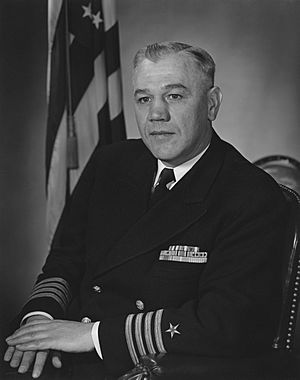Gerald Ketchum facts for kids
Quick facts for kids
Gerald L. Ketchum
|
|
|---|---|
 |
|
| Born | 5 December 1908 Bellingham, Washington |
| Died | 22 August 1992 (aged 83) Plano, Texas |
| Allegiance | |
| Service/ |
|
| Rank | |
| Battles/wars | World War II Korean War |
| Awards | Silver Star Legion of Merit Navy Commendation Medal |
Gerald L. Ketchum (born December 5, 1908 – died August 22, 1992) was a brave officer in the United States Navy. He served in two major wars: World War II and the Korean War. He was honored with the Silver Star for his courage. He also explored the icy lands of Antarctica on four different trips.
Contents
Gerald Lyle Ketchum was born in Bellingham, Washington. He joined the United States Naval Academy and finished his training in 1931.
Serving in World War II
During World War II, Ketchum was an officer in charge of a destroyer ship called the USS Perkins. He took command of the Perkins in March 1943. His ship worked in the waters near New Guinea.
On September 22, 1943, his ship was protecting other ships carrying troops. Ten Japanese torpedo planes attacked them! Ketchum bravely steered the Perkins to get between the planes and the convoy. Even though his ship was shot at a lot, he skillfully dodged two torpedoes. He also helped shoot down two enemy planes. For this heroic action, he later received the Silver Star. This is one of the Navy's highest awards for bravery.
Later, in November 1943, the Perkins was accidentally hit by an Australian troopship. The Perkins sank, and nine American sailors lost their lives. Even though Ketchum was held responsible for the accident, he was still allowed to command other ships later in his career. This was unusual and showed that the Navy still trusted him.
Exploring Antarctica
After the war, Ketchum became the commanding officer of a new icebreaker ship called the USS Burton Island.
He took the Burton Island on Operation Highjump in 1946–1947. This was the Navy's first big trip to Antarctica with many different ships. It showed that the Navy could operate in the cold Antarctic region for a long time.
Ketchum went back to Antarctica for Operation Windmill in 1947–1948. He led two ships, the Burton Island and the USS Edisto, and 500 men.
He returned to Antarctica again for Operations Deep Freeze I and II from 1955 to 1957. During these trips, he was in charge of planning and carrying out the expeditions. This included designing and setting up seven bases to support the United States' research in Antarctica.
He led the ships and aircraft through dangerous ice during Operation Deep Freeze I. In Operation Deep Freeze II, he guided the largest group of ships ever sent to Antarctica through the ice without any damage. He also helped set up a base on the Knox Coast in very difficult ice conditions. For his excellent leadership in these operations, Ketchum received the Legion of Merit.
Later Life and Legacy
When he retired from the Navy, he was promoted to the rank of rear admiral. This was to recognize his important service during the wars. He passed away in Plano, Texas, on August 22, 1992.
A place in Antarctica, called Ketchum Ridge, is named after him to honor his explorations.
Awards and Honors
- Silver Star
- Legion of Merit
- Navy Commendation Medal
- American Defense Service Medal
- American Campaign Medal
- Asiatic-Pacific Campaign Medal
- World War II Victory Medal
- National Defense Service Medal
- Korea Service Medal
- Antarctic Service Medal
- United Nations Korea Medal

